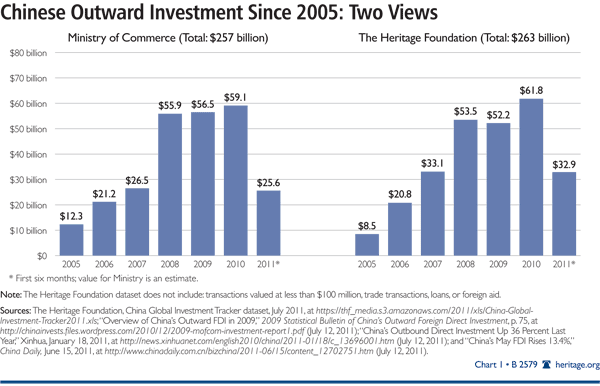Abstract: Chinese investment in the rest of the world, especially in the United States, continues to be a controversial topic. It is important for policymakers to understand the scope of China’s investments, and unless there is a specific national security consideration, market principles should guide the American policy response. Heritage Foundation China and international economics expert Derek Scissors explains why Chinese investment overseas is more an opportunity than it is a danger and lays out simple steps the U.S. should follow in response.
While ignoring China’s investment overseas would be unwise, the attention paid to it now may be a bit excessive. Five years ago, Chinese outward investment was an afterthought; it certainly has become far more than that. Yet, though important elements of the situation have changed, others have not.
Chinese investment is not taking the world by storm financially, nor will it do so in the near future. It does not pose a major threat to the U.S., either in terms of the purchase of American assets or in terms of the expansion of Chinese influence around the globe. An effective response is fairly simple.
At home, American policy concerning Chinese investment should be more transparent. Overseas, the best reply to rising Chinese commercial influence is to expand American commercial influence—for instance, through free trade agreements. These steps will help to create more economic opportunities in the U.S., will enhance America’s global position, and pose no threat to national security.
The Heritage Dataset
The Heritage Foundation’s China Global Investment Tracker is the only publicly available dataset in the field. The tracker currently contains more than 250 Chinese investments in all countries from the beginning of 2005 through the end of June 2011.[1] It excludes both bond purchases and transactions smaller than $100 million. Small transactions are not important in the totals, but they do matter to sectors, national markets, and sub-national markets that see less activity. Bond purchases are heavily concentrated in the U.S. and are examined separately.
The tracker also contains data on more than 100 large engineering and construction contracts signed since the beginning of 2005, valued at over $100 billion cumulatively. These are not investments, but they are necessary to provide a complete sense of the People’s Republic of China’s (PRC) global activity.[2] Finally, the tracker offers a list of 70 failed or seriously disrupted transactions valued at over $150 billion.
There are multiple ways to measure Chinese investment. The Heritage Foundation stresses comparability and policy relevance. Acquisitions of stakes in companies may not always technically qualify as direct investment, but they are equally relevant to policymakers. Figures issued by the individual countries in which the PRC invests can be useful in isolation but are generally not comparable. Because it is based on corporate data rather than national data, the Heritage method can be applied to every country in exactly the same way, offering genuinely comparable results.
Heritage’s figures are similar to those released by China’s Ministry of Commerce. This is somewhat odd because the ministry claims to use different methods (the State Administration for Foreign Exchange publishes yet different numbers). The ministry’s treatment of Hong Kong as attracting almost two-thirds of investment—even though Hong Kong is merely a transit point for most of the money—may bring its totals closer to the Heritage totals. In any case, the Heritage dataset is far more timely and offers much more useful information on countries and sectors than do official Chinese data.
It is worth noting that both series show only moderate investment growth since 2008. The financial crisis had an impact in late 2008 and early 2009, and while there was a clear recovery, there has not yet been a return to the powerful growth before the crisis. It may be that global asset markets cannot absorb much more than $60 billion in Chinese investment annually. This is a notable sum, of course, but it is paltry in comparison to the roughly $10 trillion in American foreign direct and portfolio investment recorded through 2010, as well as annual fluctuations in American investment that are far larger than $60 billion.
China Invests: Why and Who
The PRC’s outward investment commands global attention because the potential amounts seem to be very large. At the end of March 2011, official foreign exchange reserves exceeded $3 trillion and were climbing rapidly.[3] Over half is stored in low-yield U.S. government bonds, and Beijing would like to move some of that elsewhere if possible. This conceivably could double or triple the stock of Chinese investment outside of bonds, making it appear that a tidal wave of Chinese money is possible.
The huge stash of reserves ties directly to two core issues in China’s outward investment that are themselves closely related: the motivation for (most) outward investment and the role of state-owned enterprises (SOEs).
Official reserves grew by $453 billion in 2009, $448 billion in 2010, and $197 billion in the first quarter of 2011 alone—the PRC’s huge contribution to global imbalances. The money must be put somewhere. Under Beijing’s own, staunchly defended balance of payments system, foreign money cannot be invested in domestic projects. This is not a matter for debate; foreign money physically cannot be spent at home.[4]
The main objective of the State Administration of Foreign Exchange, hence, is nothing more than to store a great deal of money in a comparatively safe place overseas. At $3 trillion, this is not easy. Most foreign markets cannot absorb even an appreciable fraction of this total. Large losses of the funds—the “blood, sweat, and tears” of the Chinese people—risk a popular outcry. So money is stored chiefly in U.S. government bonds.[5]
Since the beginning of 2005, the PRC has also invested over $250 billion outside of bonds. The large majority of this much smaller figure was used to acquire stakes in what Beijing designates as valuable strategic assets: natural resources and, to the extent possible, technology. Other goals include enhancing political influence. The Chinese state has little interest in strong returns on its foreign exchange, since this merely adds to money that cannot be used at home and subjects China to criticism for creating global imbalances.
Chinese firms can have interests different from those of the state itself, but with regard to outward investment, the interests largely coincide. That is because state entities, especially very large and centrally controlled state entities, dominate outward investment by volume.
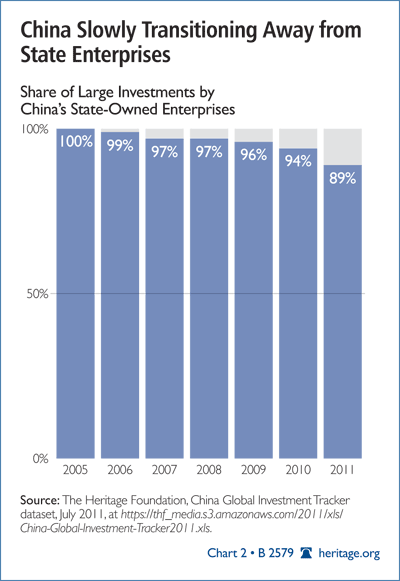
Heritage data are biased toward state entities because they have an inordinate share of the capacity and backing to make the large deals. Still, the results are overwhelming.
It is a good sign that the state share appeared to drop noticeably in the first half of 2011. There are also indications of recent diversification within the state, with more locally owned state firms participating in large-scale outward investment. Nonetheless, just four entities—oil giants China National Petroleum Corporation and Sinopec, sovereign fund China Investment Corporation (CIC), and metals conglomerate Chinalco (in descending order of investment volume)—account for about half of Chinese spending since 2005.
This should not be a surprise. A global presence is a key attribute of the national champions the PRC is working to create. The government’s “Go Out” program was aimed first at large state firms. Further, it focuses on sectors in which state firms are required by law to be dominant, such as energy and construction.[6] Gigantic subsidies, such as multibillion-dollar loans on highly concessionary terms from state-owned China Development Bank, are provided to state firms making desired investments. Those moving beyond core interests see investments rejected by regulators.[7]
China Invests: Where and What
Chinese outward investment has a short history, but the timeline also points to the major role the Chinese state has played. Until late 2004, outward investment was confined to a few friendly countries, such as Sudan and Pakistan. Then Lenovo’s purchase of IBM’s personal computer unit seemed to indicate it was possible to purchase American non-bond assets on a large scale. The rejection of a bid for UNOCAL by China National Offshore Oil Corporation (CNOOC) in mid-2005 almost immediately closed that door.
As an investment target for the PRC, Australia is quite similar to America, and after a major Chinese state firm had been blocked by the U.S. government, others shifted their attention to Australia. Less than two years later, attention shifted to sub-Saharan Africa. By 2009, the primary focus was South America, with the most intense investment to date in 2010. South America alone has now drawn over $60 billion in Chinese non-bond investment. It is entirely possible that North America will be next: There is a herd mentality among large state investors.
The map of China’s global footprint, including large engineering and construction contracts, shows truly global activity, with the PRC engaging every part of the planet. Where they have been unable to invest heavily, as in the Arab world, Chinese firms have built rail lines, roads, and factories. The countries attracting the most Chinese investment are Australia, the U.S., and Brazil, in descending order, with Argentina the most popular recent destination. Nigeria leads in terms of drawing large engineering and construction contracts. East Asia lags in part because some Chinese activity there pre-dates the tracker, but also because, like Europe, it has less abundant natural resources.
In terms of the sectors that draw the most interest, energy is the clear leader. The financial shock in the fourth quarter of 2008 effectively froze new outward investment for six months. It is therefore instructive to see what sector patterns have been since outward investment restarted in the late spring of 2009.[8]
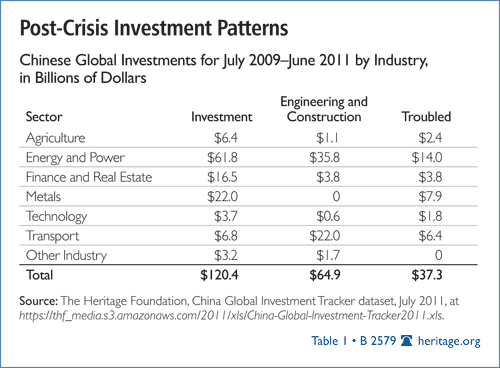
The rising price of energy has pushed up the dollar value of investments in that sector. The state energy giants continue to be willing to pay a premium, especially for South American oil assets. Though the transactions are far smaller, there is visible diversification across sectors, including the first successful spending in agriculture. Engineering and construction contracts are led by deals to build power plants. Transport sees an impressive range spanning rail lines, roads, ports, and airports.
An important feature of Chinese outward investment is the high number of setbacks. Transactions worth approximately $165 billion have been impaired or have failed since the beginning of 2005. One reason why annual totals are growing fairly slowly, despite the huge amount of funds available, is that larger volumes of Chinese investment have been shown to be impractical over the past six years.
The volume of these troubled transactions fell sharply in 2010 but rebounded in the first half of 2011, due in part to the violence in Libya. A hopeful sign for the PRC: Companies are clearly learning to be smarter investors, as well as becoming more sophisticated. There are still deals being lost unnecessarily, but this is generally happening earlier in the process and with fewer wasted resources. The spectacular, avoidable failure is increasingly rare.
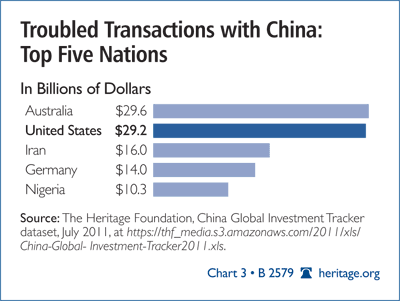
In terms of countries, it is not surprising that the top targets of Chinese firms generally see the largest amount of troubled transactions. In the U.S., if all troubled transactions since 2005 had proceeded unimpeded, Chinese investment would be almost double what it is now. There almost surely are difficulties ahead for the recent surge of Chinese spending in South America.
The Singular Case of America
Chinese investment in the U.S. is profoundly different from Chinese investment anywhere else. This is immediately apparent in the numbers.
The Heritage figure for publicly confirmed large Chinese non-bond investments since 2005 is over $30 billion. On this tally, it is not clear that Chinese investment in the U.S. has been growing since it began in earnest in 2007, featuring a $5 billion purchase by CIC of a stake in Morgan Stanley. Moreover, the first half of 2011 was weak. Starting in 2010, though, investment diversified out of finance and out of the state of New York. It thus became healthier, less dependent on financial acquisitions by CIC.
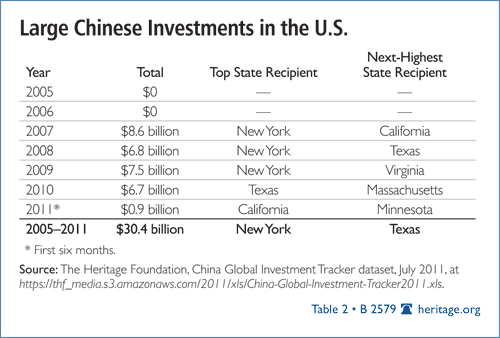
As a proportion of America’s more than $15 trillion GDP, $30 billion is trivial. There are multiple reasons for the low share of GDP, but the simplest one is that Chinese money flows overwhelmingly to American government bonds. In other major economies, $20 billion in Chinese holdings of such bonds makes headlines. For the U.S., the total is closer to $2 trillion.[9]
The Department of the Treasury puts Chinese securities holdings in the U.S. at $1.61 trillion in mid-2010, led by $1.11 trillion in Treasury debt and $360 billion in agency debt from Fannie Mae and Freddie Mac. Even this figure was too low, as the Treasury treats offshore sources, such as the Cayman Islands, as independently investing more than $1 trillion rather than serving as conduits for Chinese and other national funds.[10]
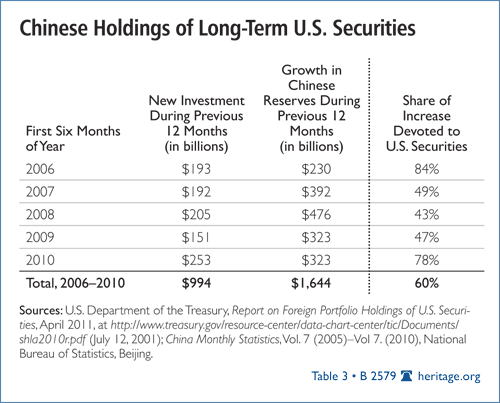
Over the four most recent years for which there are reasonable-quality data, at least 60 percent of the PRC’s foreign exchange reserves has gone into long-term American securities. The number is very likely higher that that, due to indirect Chinese investment. A sharp decline in the proportion devoted to U.S. securities in the economic expansion period of late 2006 and early 2007 was balanced by a sharp increase in late 2009 and early 2010.
Because American bonds currently offer low yields, and since there are exchange losses from a weak dollar, there is constant speculation that the PRC will abandon its position. As noted, there is no place for the money to go. The amounts involved are so large that no other economy could or would absorb them. Until Beijing changes its own rules, most of its money will remain in dollar assets, chiefly U.S. government bonds.
There can be movement among dollar assets, however, particularly from U.S. government assets to the private sector. One hundred billion dollars seems like a huge amount, but it is not especially large in terms of China’s current American bond holdings. Such a shift would even be fairly easy to implement for the PRC, given the concentration of investment in state entities. The question is whether the U.S. will permit it.
What Should China Be Able To Buy?
There are factors weighing against a huge increase in Chinese purchases of private American assets. The PRC effectively self-imposes some restrictions. From the U.S. perspective, national security–related technology is off the table. That leaves finance, resources, and manufacturing, broadly construed.
Finance. The PRC has already invested extensively in the American financial sector with no problems beyond conventional market fluctuations. Market conditions will determine future spending.
Energy. The U.S. has a great deal of coal and gas. The CNOOC–UNOCAL fiasco suggested to the Chinese side that no resource investment would be permitted. This was an overreaction, and in late 2010, CNOOC proceeded with a multibillion-dollar shale investment with Chesapeake Energy.[11] While large, this crucially involved a minority stake and met no objection. More investment will follow. It should be done carefully, since the PRC has been shown vulnerable to the countercharge that American companies cannot freely invest in China’s energy sector.
Land. Land itself is a possible investment target. Individual Chinese have bought personal property in various American cities, a phenomenon that is very likely to continue.[12] The PRC has struggled to buy large tracts of land for agriculture in many countries,[13] but the U.S. is arguably the most land-rich country in the world and will likely be more accepting. A remaining problem is that most Chinese agriculture enterprises are uncompetitive. Joint ventures with American companies may be helpful.
Manufacturing. Most of the confusion surrounding Chinese investment in the U.S. stems from manufacturing. Some manufacturing investments, such as AVIC in auto parts, proceed quickly and uneventfully. Others, such as Anshan in steel, become controversial and suffer delays.[14] There is no apparent logic to what is permitted and what is not, and the process by which some transactions are delayed is extremely murky.
In technology, the U.S. has both a policy position and a formal review process centering on the Committee on Foreign Investment in the United States (CFIUS). With respect to manufacturing, there is no policy stance, and the review process can become driven by politics in unpredictable fashion. This is a flaw in the American investment environment that should be fixed. Reviews of Chinese manufacturing investment should be quick, clear, and typically grant approval as long as specific security issues are not involved.
On the PRC’s side, dramatically greater transparency is needed. Fraud inquiries into stock exchange listings of China-based firms are dangerous with respect to access to many foreign markets, not just the U.S.[15] More important are direct subsidies provided by effective transfer of foreign exchange from the government to acquiring firms, usually in the guise of loans that are closer in nature to grants.
State firms will not acknowledge these or the huge internal subsidies that are provided through regulatory protection, free land, cheap energy, and so on. This is a difficult issue even in government-to-government talks. For inward investment, some subsidies benefit the U.S. by boosting the prices that Chinese entities are willing to pay American asset holders. Indeed, the PRC overpays for many of the assets it acquires.[16]
However, subsidies also matter to post-acquisition behavior, giving Chinese firms the potential to distort American markets. U.S. competition laws and regulations need to be able to prevent such distortions and must be stringently applied. It is incumbent upon Chinese firms to be well prepared and willing to comply fully with all laws and regulations. Failure to do so will not be reasonably excused by claims of sovereign compulsion or other poor defenses offered to date and will properly result in severe penalty.[17]
How the U.S. Should to React to Chinese Investment
Unless there is a specific national security consideration, market principles should guide the American response to Chinese outward investment. At home, the determining question should be how the functioning of markets is best served. Overseas, the U.S. should seek to enhance market mechanisms to allay concerns over rising Chinese influence. In neither case should vague political fears play a role.
In bilateral negotiations at the Strategic and Economic Dialogue and other high-level summits, the U.S. should make clear that it is willing to address Chinese concerns about access to the American market. Such a discussion, of course, will occur in tandem with discussion of American concerns, such as the variety of subsidies for state-owned enterprises.
There are also two sets of unilateral actions the U.S. should take.
- The U.S. should clarify the role of CFIUS as the sole body that can reject foreign commercial transactions. To make this credible:
- The CFIUS mandate should be extended explicitly to equipment supply contracts and other transactions that can involve national security;
- Congressional input to CFIUS decision-making should be formalized rather than being random and often surprising; and
- CFIUS should work toward a set of guidelines to assist foreign firms in understanding why transactions are rejected even though, for legitimate security reasons, the guidelines will necessarily be incomplete.
- The U.S. should respond to China’s increasing economic footprint by increasing its own footprint through the global reduction of trade and investment barriers.
- The U.S. should work with countries in the Trans-Pacific Partnership to establish a superior investment environment, including transparency with regard to subsidies;
- The U.S. should follow the free trade agreement with Colombia and Panama with further trade and investment agreements in Latin America that reduce commercial barriers on all sides; and
- The U.S. should resume its leadership role at the World Trade Organization, publicly pushing China and others toward a meaningful round of liberalization rather than toward “Doha-light.”
For its part, China should compel greater disclosure by its state entities while progressively reducing government support for its outward investment.
Conclusion: Small Steps First
China has a great deal of money to spend, but without major changes, its outward investment will continue to be confined largely to U.S. government bonds. The PRC’s smaller investment outside of bonds is dominated by state firms and targeted toward natural resources. The geographic pattern changes over time and may soon shift from the current emphasis on South America.
The U.S. draws the lion’s share of Chinese investment but comparatively little outside of bonds. The transparency of U.S. policy toward Chinese non-bond investment should be improved. In turn, Chinese firms must be able to operate properly in the American market, where disclosure requirements are high and competition laws can and should be strictly enforced.
—Derek Scissors, Ph.D., is Research Fellow in Asia Economic Policy in the Asian Studies Center at The Heritage Foundation.
